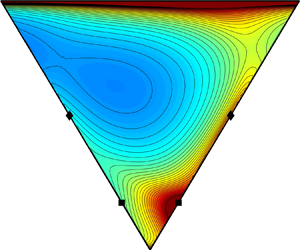Article contents
Exploring the turbulent velocity gradients at different scales from the perspective of the strain-rate eigenframe
Published online by Cambridge University Press: 12 January 2021
Abstract

Expressing the evolution equations for the filtered velocity gradient tensor (FVGT) in the strain-rate eigenframe provides an insightful way to disentangle and understand various processes such as strain self-amplification, vortex stretching and tilting, and to consider their properties at different scales in the flow. Using data from direct numerical simulation of the forced Navier–Stokes equation, we consider the relative importance of local and non-local terms in the FVGT eigenframe equations across the scales using statistical analysis. The eigenframe rotation rate (that drives vorticity tilting) is shown to exhibit highly non-Gaussian fluctuations even at large scales due to kinematic effects, but dynamically, the anisotropic pressure Hessian plays a key role. The anisotropic pressure Hessian conditioned on the eigenvalues and principal vorticity components exhibits highly nonlinear behaviour at low values of normalized local gradients, with important modelling implications. We derive a generalization of the Lumley triangle that allows us to show that the pressure Hessian has a preference for two-component axisymmetric configurations at small scales, with a transition to a more isotropic state at larger scales. Correlations between the sub-grid stress and other terms in the eigenframe equations are considered, highlighting the coupling between the sub-grid and nonlinear amplification terms, with the sub-grid term playing an important role in regularizing the system. These results provide useful guidelines for improving Lagrangian models of the FVGT, since current models fail to capture a number of subtle features observed in our results.
JFM classification
- Type
- JFM Papers
- Information
- Copyright
- © The Author(s), 2021. Published by Cambridge University Press
Footnotes
Present address: Max Planck Institute for Dynamics and Self-Organization, Am Faßberg 17, 37077 Göttingen, Germany.
References
REFERENCES
- 13
- Cited by



